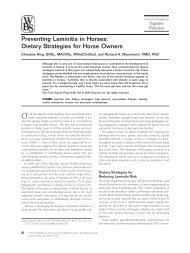Nutritional Secondary Hyperparathyroidism in the Horse
Nutritional Secondary Hyperparathyroidism in the Horse
Nutritional Secondary Hyperparathyroidism in the Horse
You also want an ePaper? Increase the reach of your titles
YUMPU automatically turns print PDFs into web optimized ePapers that Google loves.
The Parathyroid Glands 79<br />
should be radiographed rout<strong>in</strong>ely. With <strong>the</strong> method we found to be<br />
superior, viz., a ventrodorsal view of <strong>the</strong> rostra1 end of <strong>the</strong> mandible, a<br />
positive or negative diagnosis of osteitis fibrosa should offer no great<br />
difficulties. The resorption of <strong>the</strong> lam<strong>in</strong>ae durae dentes is considered<br />
almost specific for generalized osteitis fibrosa s<strong>in</strong>ce it does not occur<br />
<strong>in</strong> rickets or osteomalacia or even <strong>in</strong> advanced cases of osteoporosis<br />
[ALBRIGHT and REIFENSTEIN (1 948)].<br />
4. The Parathyroid Glands<br />
The weight <strong>in</strong>crease, <strong>the</strong> morphology, and <strong>the</strong> functional evaluation<br />
of <strong>the</strong> parathyroid glands have conclusively shown parathyroid<br />
hyperplasia and cellular hypertrophy. Regard<strong>in</strong>g <strong>the</strong> cell types <strong>the</strong><br />
changes occurr<strong>in</strong>g <strong>in</strong> nutritional secondary hyperparathyroidism <strong>in</strong> <strong>the</strong><br />
horse were disappearance of dark chief cells, predom<strong>in</strong>ance of light<br />
chief cells, and an <strong>in</strong>crease <strong>in</strong> water-clear cells. Judg<strong>in</strong>g from <strong>the</strong> cytoplasm<br />
to nucleus ratio and <strong>the</strong> size of <strong>the</strong> nucleus of <strong>the</strong> dark and light<br />
chief cells, <strong>the</strong> latter <strong>in</strong>dicate a more active state [EGER and VAN<br />
LESSEN (1954)l. The morphology of <strong>the</strong> light chief cells of NSH<br />
horses differed from that of <strong>the</strong> control and of <strong>the</strong> normal horses of<br />
Chapter I. The cells had undergone pronounced hypertrophy, <strong>the</strong><br />
nucleus was significantly enlarged, and a correspond<strong>in</strong>g <strong>in</strong>crease <strong>in</strong> <strong>the</strong><br />
cytoplasm was evidenced by an unchanged cytoplasm to nucleus ratio.<br />
EGER and VAN LESSEN (1954) also concluded that <strong>the</strong> small waterclear<br />
cells are <strong>the</strong> most active parathyroid cells and that <strong>the</strong> large<br />
water-clear cells represent early degeneration. CASTLEMAN and<br />
MALLORY (1935, 1937) stated that <strong>in</strong> primary hyperplasia of <strong>the</strong> parathyroids<br />
<strong>in</strong> man “a uniform direction of differentiation of all cells to<br />
<strong>the</strong> large water-clear cell type is <strong>the</strong> <strong>in</strong>variable f<strong>in</strong>d<strong>in</strong>g”, whereas <strong>in</strong><br />
renal secondary hyperplasia “such uniformity is lack<strong>in</strong>g. Here <strong>the</strong><br />
glands are composed almost completely of normal-sized chef cells,<br />
although a few small water-clear cells are occasionally present.” With<br />
regard to <strong>the</strong> functional state of <strong>the</strong> water-clear cells <strong>the</strong>y wrote (1935) :<br />
“When <strong>the</strong> whole gland is composed of <strong>the</strong>se cells, as <strong>in</strong> some cases<br />
of nephritis and hypertension, it is felt that hyperplasia is def<strong>in</strong>ite.”<br />
The <strong>in</strong>termediate stages dur<strong>in</strong>g <strong>the</strong> transformation of light chief<br />
cells offer some <strong>in</strong>formation on <strong>the</strong> functional state of <strong>the</strong> end product,<br />
<strong>the</strong> large water-clear cell. The first th<strong>in</strong>g that happens is a coalescence<br />
Downloaded from<br />
vet.sagepub.com by guest on April 14, 2010



